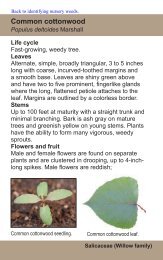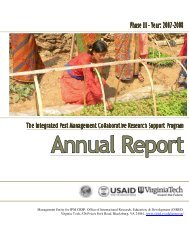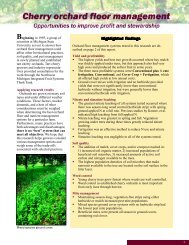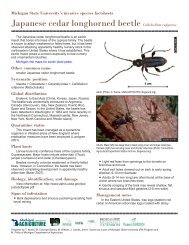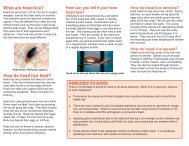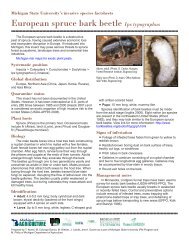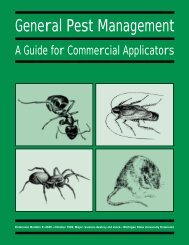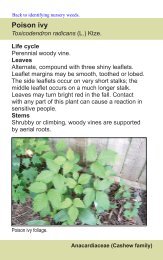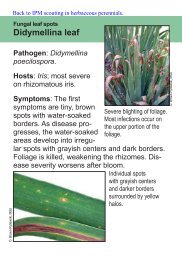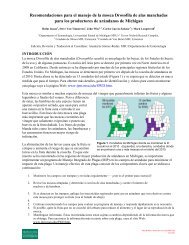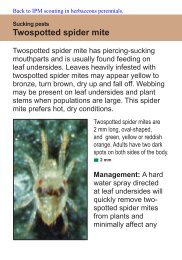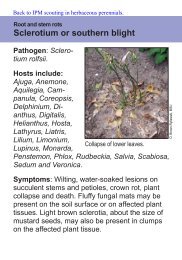Whole Manual - Michigan State University: Integrated Pest ...
Whole Manual - Michigan State University: Integrated Pest ...
Whole Manual - Michigan State University: Integrated Pest ...
Create successful ePaper yourself
Turn your PDF publications into a flip-book with our unique Google optimized e-Paper software.
DERMAL TOXICITY—The ability of a pesticide to cause<br />
acute illness or injury to a human or animal when<br />
absorbed through the skin. (See exposure route.)<br />
DESICCANT—A type of pesticide that draws moisture<br />
or fluids from a pest, causing it to die. Certain desiccant<br />
dusts destroy the waxy outer coating that holds moisture<br />
within an insect’s body.<br />
DETOXIFY—To render a pesticide’s active ingredient or<br />
other poisonous chemical harmless.<br />
DIAGNOSIS—The positive identification of a problem<br />
and its cause.<br />
DILUENT—Any liquid, gas, or solid material used to<br />
dilute or weaken a concentrated pesticide.<br />
DISEASE—A disturbance of normal plant function;<br />
caused by bacteria, fungi, virus, or environmental conditions.<br />
DISEASE CYCLE—The basic chain of events involved in<br />
disease development.<br />
DISINFECTANT—A chemical or other agent that kills or<br />
inactivates disease-producing microorganisms. Chemicals<br />
used to clean or surface-sterilize inanimate objects.<br />
DOSE, DOSAGE—Quantity, amount, or rate of pesticide<br />
applied to a given area or target.<br />
DRIFT—The airborne movement of a pesticide spray or<br />
dust beyond the intended target area.<br />
DRIFT MANAGEMENT PLAN—A written plan required<br />
of commercial and private applicators by <strong>Michigan</strong><br />
Regulation 637 whenever there is a chance of a spray application<br />
drifting from the target onto non-target and off-site<br />
sensitive areas.<br />
DUST—A finely ground, dry pesticide formulation containing<br />
a small amount of active ingredient and a large<br />
amount of inert carrier or diluent such as clay or talc.<br />
ECONOMIC DAMAGE—The amount of injury that will<br />
justify the cost of applied control measures.<br />
ECONOMIC INJURY LEVEL (EIL)—The smallest pest<br />
population that will cause economic loss to the crop.<br />
ECONOMIC THRESHOLD (ET, ACTION THRESH-<br />
OLD)—The pest density at which a control tactic should<br />
be taken to prevent the pest population from increasing<br />
to the economic injury level.<br />
ECOSYSTEM—The pest management unit. It includes a<br />
community (of populations) with the necessary physical<br />
and biotic (food, hosts) supporting factors that allow an<br />
infestation of pests to persist.<br />
EMULSIFIABLE CONCENTRATE—A pesticide formulation<br />
produced by mixing or suspending the active<br />
ingredient (the concentrate) and an emulsifying agent in<br />
a suitable carrier. When it’s added to water, a milky<br />
emulsion is formed.<br />
EMULSIFYING AGENT (EMULSIFIER)—A chemical<br />
that aids in the suspension of one liquid in another that<br />
normally would not mix together.<br />
EMULSION—A mixture of two liquids that are not soluble<br />
in each other. One is suspended as very small droplets<br />
in the other with the aid of an emulsifying agent.<br />
ENCAPSULATED FORMULATION—A pesticide formulation<br />
with the active ingredient enclosed in capsules<br />
of polyvinyl or other materials; principally used for slow<br />
release.<br />
ENDANGERED SPECIES—A plant or animal species<br />
whose population is reduced to the extent that it is near<br />
extinction and that a federal agency has designated as<br />
being in danger of becoming extinct.<br />
ENTRY INTERVAL—See re-entry interval.<br />
ENVIRONMENT—All of our physical, chemical, and<br />
biological surroundings, such as climate, soil, water, and<br />
air, and all species of plants, animals, and microorganisms.<br />
ENVIRONMENTAL PROTECTION AGENCY (EPA) —<br />
The federal agency responsible for ensuring the protection<br />
of humans and the environment from potentially<br />
adverse effects of pesticides.<br />
EPA ESTABLISHMENT NUMBER—A number assigned<br />
to each pesticide production plant by the EPA. The number<br />
indicates the plant at which the pesticide product was<br />
produced and must appear on all labels of that product.<br />
EPA REGISTRATION NUMBER—An identification<br />
number assigned to a pesticide product when the product<br />
is registered by the EPA for use. The number must<br />
appear on all labels for a particular product.<br />
ERADICATION—The complete elimination of a (pest)<br />
population from a designated area.<br />
EXOSKELETON—The external hardened covering or<br />
skeleton of an insect to which muscles are attached internally;<br />
periodically shed.<br />
EXPOSURE ROUTE OR COMMON EXPOSURE<br />
ROUTE—The manner (dermal, oral, or inhalation/respiratory)<br />
by which a pesticide may enter an organism.<br />
FAMILY—See taxonomy<br />
FIFRA—The Federal Insecticide, Fungicide, and Rodenticide<br />
Act; a federal law and its amendments that control pesticide<br />
registration and use.<br />
FLOWABLE—A pesticide formulation in which a very<br />
finely ground solid particle is suspended (not dissolved)<br />
in a liquid carrier.<br />
FORMULATION—The pesticide product as purchased,<br />
containing a mixture of one or more active ingredients,<br />
carriers (inert ingredients), and other additives making it<br />
easy to store, dilute, and apply.<br />
FRUITING BODY—The part of a fungus that contains<br />
spores.<br />
FUMIGANT—A pesticide formulation that volatilizes,<br />
forming a toxic vapor or gas that kills in the gaseous<br />
state. Usually, it penetrates voids to kill pests.<br />
FUNGICIDE—A chemical used to control fungi.<br />
Appendix C<br />
94<br />
Vegetable Crop <strong>Pest</strong> Management



